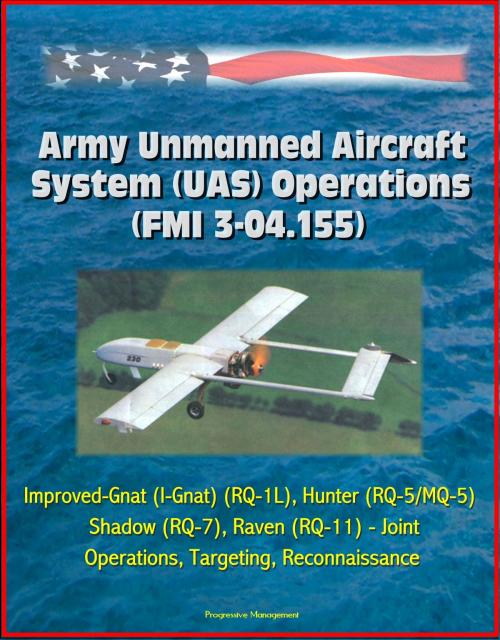Army Unmanned Aircraft System Operations (FMI 3-04.155) - Improved-Gnat (I-Gnat) (RQ-1L), Hunter (RQ-5/MQ-5), Shadow (RQ-7), Raven (RQ-11) - Joint Operations, Targeting, Reconnaissance
Nonfiction, Science & Nature, Technology, Aeronautics & Astronautics, History, Military, Aviation| Author: | Progressive Management | ISBN: | 9781301664542 |
| Publisher: | Progressive Management | Publication: | February 11, 2013 |
| Imprint: | Smashwords Edition | Language: | English |
| Author: | Progressive Management |
| ISBN: | 9781301664542 |
| Publisher: | Progressive Management |
| Publication: | February 11, 2013 |
| Imprint: | Smashwords Edition |
| Language: | English |
This is the Army's keystone doctrine for how to fight and sustain Army Unmanned Aircraft Systems (UAS). Chapter 1 focuses on UAS organizations, missions, and fundamentals. Chapter 2 provides an overview of Army UAS and system descriptions and capabilities. Chapter 3 provides an overview of joint UAS and the capabilities they give the maneuver commander. Chapter 4 discusses UAS planning considerations all users must be familiar with for the successful execution of UAS operations. Chapter 5 discusses employment of the UAS. Chapter 6 discusses sustainment requirements and considerations for UAS operations at all echelons. UAS operations support battlefield commanders and their staffs as they plan, coordinate, and execute operations. UAS increase the situational awareness (SA) of commanders through intelligence, surveillance, and reconnaissance (ISR).
Chapter 1 * ORGANIZATION, MISSIONS, and FUNDAMENTALS * Section I - General * Unmanned aircraft system Types * Organization * Mission * Capabilities * Limitations * Fundamentals * Echelons of Support * Section II - Unmanned Aircraft System Organizations * RQ-1L I-Gnat Organization * RQ-5/MQ-5 Hunter Aerial Reconnaissance Company * RQ-7 Shadow Aerial Reconnaissance Platoon * RQ-11 Raven Team * Section III - Duty Descriptions and Responsibilities * Company Commander * Platoon Leader * Unmanned aircraft system Operations Officer (150U) * First Sergeant * Platoon Sergeant * Air Mission Commander * Unmanned aircraft system Operator (15W) * External Pilot (RQ-5/MQ-5 Hunter Only) * Unmanned Aerial System Operator (RQ-11 Raven) * Chapter 2 * ARMY UNMANNED AERIAL SYSTEMS * RQ-1L I-Gnat * RQ-5/MQ-5 Hunter * RQ-7 Shadow * RQ-11 Raven * Chapter 3 * JOINT UNMANNED AERIAL SYSTEMS * Section I - Joint UAS Request Procedures * Joint Command Architecture * Unmanned aircraft system Support * Section II - Air Force * RQ-4 Global Hawk * RQ/MQ-1 Predator * MQ-9 Predator B * Force Protection Aerial Surveillance System-Desert Hawk * Section III - Navy * RQ-2 Pioneer * RQ-8B Fire Scout * Section IV - Marine Corps * FQM-151 Pointer * Dragon Eye * Silver Fox * Scan Eagle * Section V - Coast Guard * Eagle Eye * Section VI-Special Operations Command * CQ-10 SnowGoose * FQM-151 Pointer * RQ-11 Raven * Dragon Eye * Chapter 4 * UNMANNED AERIAL SYSTEMS MISSION PLANNING CONSIDERATIONS * Section I - Overview * Section II - Employment Considerations * Location of Unmanned aircraft systems * Sustained Operations * Terrain and Weather * Sensor Considerations * Threat Considerations * Time/Resources Available * Dynamic Retasking * Civil Considerations (Combat Operations) * Section III - Mission Planning Process * Mission Supported Unit * Echelons Above Brigade Combat Team Tasking and Planning * Brigade and Below Planning Responsibilities * Brigade and Below Tasking/Planning * Unmanned aircraft system Unit Planning Process * Post Mission Actions * Section IV - Army Airspace Command and Control * Section V - Command and Control * Levels of Interoperability * Communications * Using a Remote Video Terminal * Section VI - Risk Mitigation * Safety * Risk Management * Unmanned aircraft system Safety Considerations * Chapter 5 * UNMANNED AERIAL SYSTEMS EMPLOYMENT * Section I - Reconnaissance and Surveillance * Reconnaissance * Unmanned aircraft system Reconnaissance Fundamentals * Actions on the Objective * Data Exfiltration * Surveillance * Section II - Security Operations * Screen * Guard and Cover Operations * Section III-Unmanned Aircraft System Targeting * Facilitate Targeting * Precision of Target Locations * Facilitate Command and Control * Facilitate Movement * Section IV - Manned-Unmanned Team Operations * Manned-Unmanned Team Missions * Reconnaissance, Surveillance, and Target Acquisition Missions * Screen Missions * Movement to Contact * Aerial Target Designation * Artillery Fire Support * Close Air Support * Kill Box * Section V - Personnel Recovery
This is the Army's keystone doctrine for how to fight and sustain Army Unmanned Aircraft Systems (UAS). Chapter 1 focuses on UAS organizations, missions, and fundamentals. Chapter 2 provides an overview of Army UAS and system descriptions and capabilities. Chapter 3 provides an overview of joint UAS and the capabilities they give the maneuver commander. Chapter 4 discusses UAS planning considerations all users must be familiar with for the successful execution of UAS operations. Chapter 5 discusses employment of the UAS. Chapter 6 discusses sustainment requirements and considerations for UAS operations at all echelons. UAS operations support battlefield commanders and their staffs as they plan, coordinate, and execute operations. UAS increase the situational awareness (SA) of commanders through intelligence, surveillance, and reconnaissance (ISR).
Chapter 1 * ORGANIZATION, MISSIONS, and FUNDAMENTALS * Section I - General * Unmanned aircraft system Types * Organization * Mission * Capabilities * Limitations * Fundamentals * Echelons of Support * Section II - Unmanned Aircraft System Organizations * RQ-1L I-Gnat Organization * RQ-5/MQ-5 Hunter Aerial Reconnaissance Company * RQ-7 Shadow Aerial Reconnaissance Platoon * RQ-11 Raven Team * Section III - Duty Descriptions and Responsibilities * Company Commander * Platoon Leader * Unmanned aircraft system Operations Officer (150U) * First Sergeant * Platoon Sergeant * Air Mission Commander * Unmanned aircraft system Operator (15W) * External Pilot (RQ-5/MQ-5 Hunter Only) * Unmanned Aerial System Operator (RQ-11 Raven) * Chapter 2 * ARMY UNMANNED AERIAL SYSTEMS * RQ-1L I-Gnat * RQ-5/MQ-5 Hunter * RQ-7 Shadow * RQ-11 Raven * Chapter 3 * JOINT UNMANNED AERIAL SYSTEMS * Section I - Joint UAS Request Procedures * Joint Command Architecture * Unmanned aircraft system Support * Section II - Air Force * RQ-4 Global Hawk * RQ/MQ-1 Predator * MQ-9 Predator B * Force Protection Aerial Surveillance System-Desert Hawk * Section III - Navy * RQ-2 Pioneer * RQ-8B Fire Scout * Section IV - Marine Corps * FQM-151 Pointer * Dragon Eye * Silver Fox * Scan Eagle * Section V - Coast Guard * Eagle Eye * Section VI-Special Operations Command * CQ-10 SnowGoose * FQM-151 Pointer * RQ-11 Raven * Dragon Eye * Chapter 4 * UNMANNED AERIAL SYSTEMS MISSION PLANNING CONSIDERATIONS * Section I - Overview * Section II - Employment Considerations * Location of Unmanned aircraft systems * Sustained Operations * Terrain and Weather * Sensor Considerations * Threat Considerations * Time/Resources Available * Dynamic Retasking * Civil Considerations (Combat Operations) * Section III - Mission Planning Process * Mission Supported Unit * Echelons Above Brigade Combat Team Tasking and Planning * Brigade and Below Planning Responsibilities * Brigade and Below Tasking/Planning * Unmanned aircraft system Unit Planning Process * Post Mission Actions * Section IV - Army Airspace Command and Control * Section V - Command and Control * Levels of Interoperability * Communications * Using a Remote Video Terminal * Section VI - Risk Mitigation * Safety * Risk Management * Unmanned aircraft system Safety Considerations * Chapter 5 * UNMANNED AERIAL SYSTEMS EMPLOYMENT * Section I - Reconnaissance and Surveillance * Reconnaissance * Unmanned aircraft system Reconnaissance Fundamentals * Actions on the Objective * Data Exfiltration * Surveillance * Section II - Security Operations * Screen * Guard and Cover Operations * Section III-Unmanned Aircraft System Targeting * Facilitate Targeting * Precision of Target Locations * Facilitate Command and Control * Facilitate Movement * Section IV - Manned-Unmanned Team Operations * Manned-Unmanned Team Missions * Reconnaissance, Surveillance, and Target Acquisition Missions * Screen Missions * Movement to Contact * Aerial Target Designation * Artillery Fire Support * Close Air Support * Kill Box * Section V - Personnel Recovery















